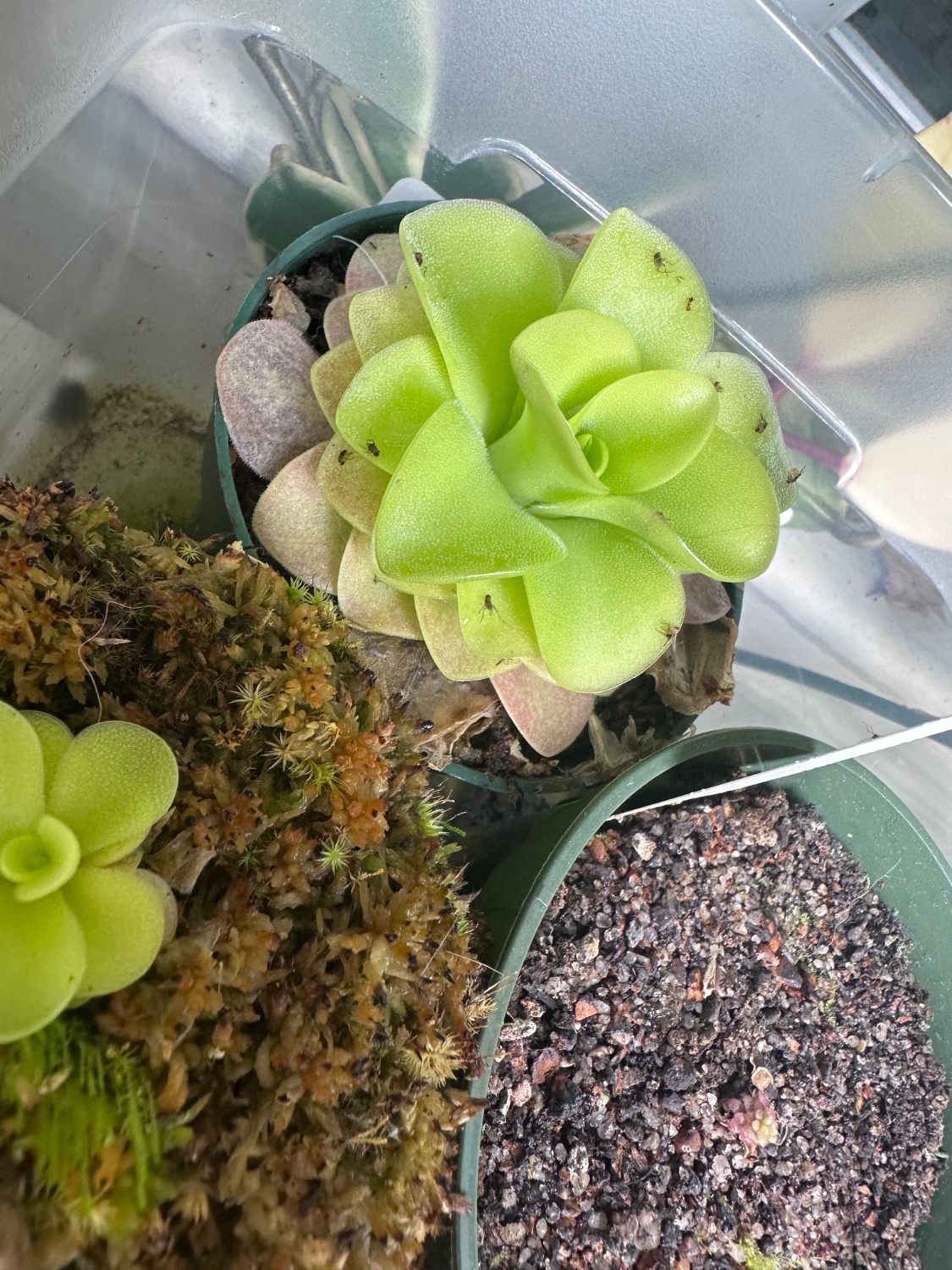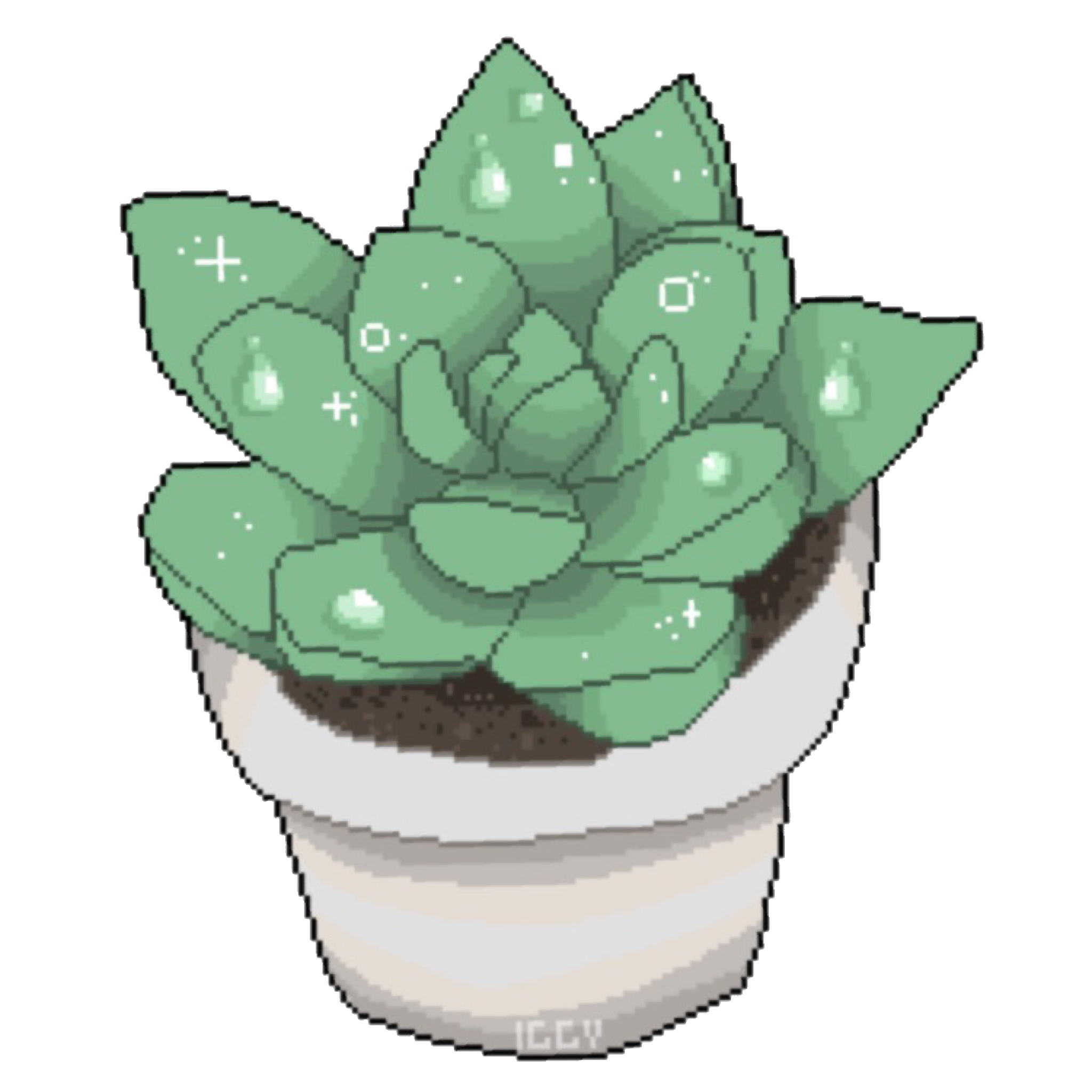They weren’t very happy to begin with, but in the last few days, they really look awful. Especially my ping.
I’ve read they both like lots of light, so I placed them into my growtent.
But this certainly isn’t the answer. For me, it doesn’t look like sunburn. Sure, the colors now look more bright, but I’ve also put them a few times outside into the sun.
My problem is, that the lower leaves constantly get mushy, and that both often don’t produce lots of dew.
Is the surface/ substrate too dry?
The Drosera alicae is sitting in its original substrate, which was peat with perlite, and I’ve put a layer of LECA to fill up the rest, which is about 2 cm (1"). It’s often sitting in a bit of (pure) water, but I regularly flush it out and let it dry up a little bit in between (spongy texture).
The Pinguicula (probably agnata, unspecified) is looking worse.
I have it sitting in LECA, and water it with a heavily diluted fertilizer (about 1/3 of what my other houseplants get) and regularly soak and flush it with pure water.
It looked way better a week ago, but is slowly declining, even before I put it into the light.
Is it rotting?




I care for most of my carnivores (bladderworts, sundews, VFTs, mexican and temperate pings) in the same way which is just letting them sit in a tray of distilled, RO, or rain water. From my experience, they all like more light than you think and sundews in particular (your D. aliciae for example) actually stop producing dew when they don’t get enough light. I’m not sure what the intention of the leca is but I don’t generally use it unless for aroids that want more airflow for their roots.
As for the ping, if its an agnata mix, then while its in its growing phase, its also fine to keep it in a bit of water. I have mine in a ping mix though which is peat, sand, and turface (I just buy a mix from petflytrap.com). Again, low mineral water so distilled, RO, rainwater, I don’t use any ferts for my carnivores but I know foliar feeding is becoming more popular and root feeding seems to be ok for some sars but I haven’t taken that plunge myself.
Personally, I’d remove all the leca and just put them under some bright lights in a tray of clean low mineral water (if you have a total dissolved solids reader use it, water should have a TDS < 50). They may still suffer and old leaves may die but look out for any new growth and what that looks like. Carnivore leaves are not like other houseplants, they cycle through and die but the crown should be plump, healthy, and puttibg out new growth fairly consistently (unless its a temperate species that needs a hibernation but that’s a different story).
Thank you for your elaborate response!
I’m not sure what the intention of the leca is but I don’t generally use it unless for aroids that want more airflow for their roots.
I have all of my plants (calathea, weed, doesn’t matter) in hydroculture, with the only exception being the Drosera. I’ve noticed that some CPs really need moss (or peat, as long as it exchanges ions to acid), while some other do well in just soilless media and are more forgiving, like my nepenthes.
If you’re a carnivorous plant nerd, I can show you my learnings if you’re interested, maybe you’ll learn something new.
LECA is completely inert (especially if soaked multiple times in pure water) and doesn’t compact, so you don’t need to repot for years. Many CPs don’t care about the substrate at all, as long as it doesn’t have too many nutrients, and LECA is great for that, because it’s airy and doesn’t compact, opposed to moss or peat, and won’t attract pests.
Watering is also way easier.I don’t use any ferts for my carnivores but I know foliar feeding is becoming more popular and root feeding seems to be ok for some sars but I haven’t taken that plunge myself.
I lightly fertilize them from time to time, mainly foliar feeding, but I’ve decided to stop that due to the risks you mentioned.
I think if they are hungry, they’ll catch their own prey.They may still suffer and old leaves may die but look out for any new growth and what that looks like
It’s my first time growing CPs. Is it possible that the ping got more and longer light hours, and therefore changed from the winter succulent to the summer phase? Do the succulent leaves die when summer arrives? Because the newer ones look more spoon shaped.
Thanks for the info on LECA, good to know and may be a good experiment for me! I have an N. ‘gaya’ that’s just putting out basals like no other and I don’t know what to do with all the babies.
But the leaves I can see on your ping (at least based on the first pic where I can see the leaves a bit better) look like summer leaves still. Winter leaves are more tightly compacted, smaller, and generally not sticky. The winter leaves will also slowly die back as they form new summer leaves, leaf turnover rate is just higher in CPs.
 here’s an example of my P. ‘Hanka’ still fully in winter rosette
here’s an example of my P. ‘Hanka’ still fully in winter rosette And my P. ‘Tina’ with mostly winter but some new summer leaves finally starting to emerge
And my P. ‘Tina’ with mostly winter but some new summer leaves finally starting to emerge Vs a few other species that are fully in summer foliage now (yes I have a fruit fly/gnat problem right now haha)
Vs a few other species that are fully in summer foliage now (yes I have a fruit fly/gnat problem right now haha)I will mention the one D. aliciae you showed that caught an ant did look like its crown was starting to grow new leaves and some of the newer ones had a bit of dew so I think it was bouncing back at least. Older sundew leaves also start to lose dew esp if its caught a lot of bugs and expended energy, to gain more energy/nutrients.

I’m not a great photographer but hopefully you can see in that pic how my D. adelae has some very dewy leaves and some quite dry ones (granted this plant is also newer and most of the dry leaves are from its previous environment).
Don’t know if the pictures were helpful at all but hopefully your CPs bounce back! They’re more resilient than people tend to think. Always happy to try and answer any more questions too!
Thank you so much for your passionate answers!
I found them very helpful.Your plants (and pictures too) also look absolutely beautiful!
It’s always a pleasure to see people like you, who are so enthusiastic about niche hobbies, showing or explaining me stuff.I wanna see more of that. Please do a few posts about your collection in this community, I would probably not be the only one wanting to see it!
I find carnivorous plants very fascinating. Especially their metabolism and environmental conditions they withstand (or: need and thrive). It would be so cool if more people had these amazing plants, especially in how easy they are to care for in theory!
I’ve read/ understood that any minerals are a big problem for these plants, and I bet the leca provide enough minerals to cause issues. I’d repot asap into a peat/ horticultural sand mix and hope they bounce back, but do more research to confirm my thought process.
I soaked and flushed the LECA multiple times. It showed no minerals left with my EC meter.
From what I’ve heard, pings do well in mineralic mixes like pumice, so LECA shouldn’t be much of a problem. It looked pretty good for the last few weeks, but suddenly not anymore…
That’s fair, I hadn’t even heard of it till I came across this post: https://mander.xyz/post/28051700
It’s possible that even though you washed it, the leca are “leeching” minerals. I totally agree on the pumice thing, in theory they should both work. But I don’t know if that works out in practice, for instance horticultural sand is also branded as “inert” media but is absolutely safe for carnivores as well as pumice. Either way, best of luck figuring out what’s going on. That’s pretty frustrating, I’ve certainly killed some drosera and not known why.


